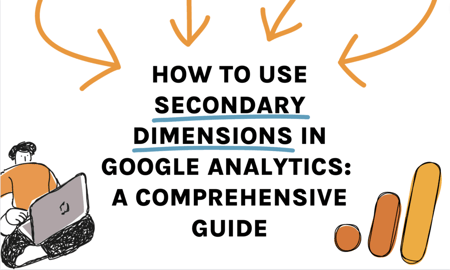Optimize Your Reporting Precision With Additional Measurements
In the world of information evaluation, the mission for accuracy and depth is a perpetual pursuit. Secondary dimensions supply a portal to augmenting reporting precision by offering a diverse lens whereby to watch information. Imagine the power of unraveling detailed layers of details that lie beyond the surface area metrics, supplying a richer tapestry of understandings waiting to be discovered. As we start this journey of leveraging additional measurements, the landscape of reporting precision bids with pledges of boosted clarity and strategic decision-making.
Relevance of Secondary Dimensions
Using secondary measurements is necessary for enhancing the deepness and granularity of reporting insights in information analysis. Additional dimensions enable experts to segment and filter data based on particular requirements, providing an extra customized and targeted analysis.
In addition, additional dimensions aid in determining connections and connections that might not be promptly noticeable when evaluating information with just key measurements. This deeper level of understanding can cause more enlightened decision-making and critical planning within a company. By leveraging secondary dimensions efficiently, companies can reveal covert chances, pinpoint locations for improvement, and optimize their total efficiency.
Implementing Secondary Measurements
To include secondary measurements efficiently right into data evaluation processes, businesses must take on an organized approach that aligns with their coverage objectives and logical objectives. Applying additional dimensions involves picking the ideal dimensions that provide much deeper understandings right into primary information metrics. It is essential to identify which additional dimensions will improve the understanding of the key data being evaluated. Companies should consider aspects such as the sort of data being gathered, the specific metrics they wish to assess, and the key efficiency signs (KPIs) they are concentrated on enhancing.
Additionally, businesses require to ensure that the chosen additional measurements relate to the primary data and offer significant context without causing details overload. Carrying out secondary measurements also calls for specifying clear logical questions that the added dimensions will certainly help address. By structuring the implementation process around these factors to consider, services can maximize the value stemmed from secondary dimensions and enhance the precision and depth of their coverage.
Analyzing Data With Secondary Dimensions

One trick facet of assessing data with secondary measurements is to make certain that the selected dimensions line up with your certain logical goals. Selecting the right additional dimensions can give context and subtlety to your primary data metrics, allowing you to attract more precise conclusions and make informed decisions based upon the understandings gained.
Furthermore, leveraging additional dimensions successfully can aid in identifying outliers, comprehending the impact of various variables on your vital efficiency indications, and acquiring an extensive sight of your information landscape. By diving right into data with additional dimensions, you can improve the deepness and top quality of your analysis, bring about more robust coverage and workable end results.

Enhancing Insights With Second Dimensions
Checking out information via additional measurements not just grows analysis but also magnifies the possibility for revealing important insights that can significantly boost reporting accuracy. By adding secondary explanation measurements to your records, you can acquire an extra thorough understanding of the relationships in between different data factors. When evaluating data with primary measurements alone., this boosted point of view enables you to determine patterns, fads, and connections that may have been forgotten.

Essentially, leveraging second dimensions empowers you to draw out richer understandings from your data, enabling you to make even more educated decisions and optimize your coverage accuracy.
Ideal Practices for Second Dimensions
Using secondary dimensions successfully requires mindful consideration of key methods to boost data evaluation and reporting accuracy. When implementing secondary dimensions, it is essential to align them with your primary metrics to derive significant insights. One best method is to use additional measurements sparingly, concentrating on those that straight contribute to the details analysis goals. By preventing the lure to include too much dimensions, you can preserve clarity in your coverage and stop details overload.
An additional critical technique is to explore different combinations of additional and main dimensions to uncover distinct relationships and patterns within your information. This repetitive method can reveal check my source beneficial understandings that may have been forgotten or else. Additionally, it is very important to regularly assess and improve your second go to the website dimension choices to guarantee they remain pertinent and lined up with your evolving reporting requirements.
In addition, recording the rationale behind your option of additional dimensions can supply context for future analysis and promote collaboration within your group. By complying with these ideal methods, you can maximize the efficiency of secondary dimensions in boosting your reporting precision and driving informed decision-making.
Final Thought
Integrating additional measurements in information evaluation is critical for making the most of reporting accuracy and obtaining much deeper understandings into performance patterns. Implementing ideal methods for secondary measurements boosts the deepness of analysis and enhances the significance of reporting results.
Moreover, secondary measurements aid in recognizing correlations and connections that may not be right away evident when assessing information with only primary measurements. Executing additional dimensions includes selecting the ideal dimensions that give much deeper understandings right into key information metrics. Carrying out second measurements also requires defining clear analytical concerns that the additional dimensions will assist answer.When evaluating information with additional dimensions, it is essential to concentrate on removing valuable insights that match main data metrics. By including second measurements into your evaluation, you can discover patterns, trends, and relationships that might not be evident when looking at the data from a key dimension alone.